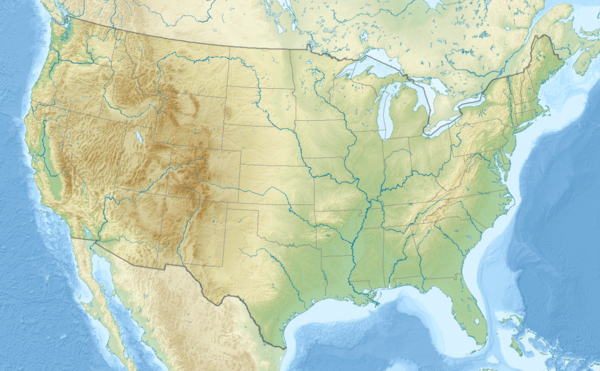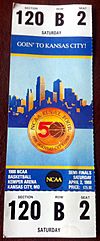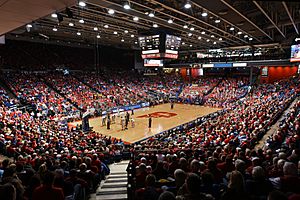NCAA Division I men's basketball tournament facts for kids
 |
|
| Sport | College basketball |
|---|---|
| Founded | 1939 |
| Inaugural season | 1939 |
| Organising body | NCAA |
| No. of teams | 68 |
| Country | United States |
| Most recent champion(s) |
Florida Gators (3rd title) (2025) |
| Most titles | UCLA (11) |
| TV partner(s) |
|
| Streaming partner(s) | Paramount+ Max |
The NCAA Division I men's basketball tournament is a huge basketball competition in the United States. It's often called March Madness or The Big Dance. This tournament decides the national champion for men's college basketball at the Division I level.
The tournament happens mostly in March and features 68 teams. It first started in 1939. March Madness is famous for its exciting upsets, where underdog teams beat highly favored ones. This makes it one of the most popular yearly sports events in the U.S.
The current format with 68 teams began in 2011. Before that, the number of teams changed a lot, from just 8 to as many as 53. For the first time ever, the tournament was canceled in 2020 because of the COVID-19 pandemic. In 2021, all games were played in Indiana to keep everyone safe.
Many different schools have won the tournament. UCLA has won the most titles with 11 championships. Their coach, John Wooden, won 10 of those titles. Other top winners include the University of Kentucky (8 titles), University of Connecticut and University of North Carolina (6 titles each), Duke University and Indiana University (5 titles each), and the University of Kansas (4 titles). The University of Florida and Villanova University each have 3 championships.
All tournament games are shown on TV by CBS, TBS, TNT, and truTV. The TV show is called NCAA March Madness. These TV networks pay a lot of money for the rights to show the games. The NCAA then shares this money with the colleges that play in the tournament. This helps fund college sports programs.
The tournament is also famous for "bracket contests." Millions of people fill out brackets each year, trying to guess the winners of every game. It's a fun way for fans to get involved!
Contents
Tournament History
How it Started (1939–1970)
The very first tournament was held in 1939. The Oregon team won it. The idea for the tournament came from Ohio State coach Harold Olsen.
From 1939 to 1950, only eight teams played in the NCAA tournament. Teams were chosen from different parts of the country. Sometimes, really good teams were left out because only one team from each area could play. In 1951, the tournament grew to 16 teams. This allowed more teams to join, including some that didn't win their conference.
At first, the tournament had East and West regions, and the winners played for the national championship. In 1952, they created four regions. The winners of these regions would then meet in the national semifinals and championship. This is similar to how the "Final Four" works today.
For many years, the NCAA tournament competed with another big event called the National Invitation Tournament (NIT). The NIT was very popular, especially because it was held in New York City. In 1950, the City College of New York even won both the NIT and the NCAA tournament! Soon after, the NCAA made a rule that teams couldn't play in both.
Growing Bigger (1971–1984)
In the 1970s, two big changes made the NCAA tournament the most important college basketball event. First, in 1971, the NCAA said that if a team turned down an invitation to their tournament, they couldn't play in any other postseason tournaments. This made sure the best teams chose the NCAA.
Second, starting in 1975, the NCAA allowed more than one team from the same conference to play. Before this, only the conference champion could go. This change meant more strong teams could compete.
To fit more teams, the tournament expanded to 32 teams in 1975. Then, it grew to 40 teams in 1979 and 48 teams in 1980.
During this time, teams also started to be "seeded." This means they were ranked from 1 to 16 in each region. Seeding helps make sure the best teams don't play each other too early in the tournament.
Modern Era (1985–Present)
In 1985, the tournament expanded to 64 teams. This meant every team had to win six games to become champion. This change made the tournament even more popular.
Since 1997, the regional names have been South, East, Midwest, and West. From 2004 to 2006, regions were named after their host cities, but they went back to geographic names in 2007.
The Final Four games, which are the last two rounds, used to be played in basketball arenas. But since 1996, they have been played in large indoor football stadiums. This allows many more fans to watch the games.
In 2001, the tournament grew to 65 teams, adding a "play-in game." This game was for the two lowest-ranked teams to earn a spot in the main bracket. In 2011, the tournament expanded to 68 teams, adding three more play-in games. These four games are now called the "First Four."
In 2016, the NCAA introduced a new "NCAA March Madness" logo for the whole tournament. This made the event look more unified.
Because of the COVID-19 pandemic, the 2020 tournament was canceled. In 2021, all games were played in Indiana to keep everyone safe. The tournament returned to its normal format in 2022.
Tournament Format
The tournament has 68 teams that play in a single-elimination bracket. This means if a team loses, they are out!
- Automatic Qualifiers: 32 teams get into the tournament by winning their conference championship. These conference tournaments happen in the two weeks before March Madness.
- At-Large Bids: The other 36 teams are chosen by a special group called the Selection Committee. They pick these teams based on how well they played during the regular season.
The Selection Committee also ranks all 68 teams from 1 to 68. They then place them into a bracket, which is revealed on a day called Selection Sunday. Once the bracket is set, the matchups for later rounds are already decided.
The tournament is split into four regions. Each region has 16 to 18 teams. The regions are named after the cities where the later rounds (regional semifinals and finals) are played. These host cities change each year.
The tournament takes place over three weekends:
- First Weekend: The "First Four" games happen first, where 8 teams play for the last 4 spots. Then, the First Round (64 teams) and Second Round (32 teams) are played.
- Second Weekend: This is when the "Sweet Sixteen" (regional semifinals, 16 teams) and "Elite Eight" (regional finals, 8 teams) games take place.
- Third Weekend: This is the "Final Four," where the last 4 teams play in the national semifinals. The winners then play in the Championship game.
All games are scheduled so teams have a day of rest between matches.
| Round | Teams Remaining |
Teams Competing |
Games | Week | Dates |
|---|---|---|---|---|---|
| First Four (play-in round) | 68 | 8 | 4 | 1st | Tuesday & Wednesday |
| First round | 64 | 64 | 32 | Thursday & Friday | |
| Second round | 32 | 32 | 16 | Saturday & Sunday | |
| Sweet Sixteen (regional semifinals) | 16 | 16 | 8 | 2nd | Thursday & Friday |
| Elite Eight (regional finals) | 8 | 8 | 4 | Saturday & Sunday | |
| Final Four (national semifinals) | 4 | 4 | 2 | 3rd | Saturday |
| Championship game | 2 | 2 | 1 | Monday |
How Teams are Seeded
The Selection Committee ranks all 68 teams from 1 to 68. This is called their true seed. Then, they place teams into the four regions, giving each a seed from No. 1 to No. 16. The best four teams overall are the No. 1 seeds in each region.
The committee tries to balance the strength of teams in each region. They also try to avoid having teams from the same conference play each other too early in the tournament. Sometimes, a team might be moved up or down a seed line to make the bracket fair.
Since 2017, the Selection Committee has released a preview of the top 16 teams three weeks before Selection Sunday. This gives fans an early look at some of the top contenders.
Where Games are Played
All tournament games are played at neutral locations. This means teams are not allowed to play on their home court during the first, second, or regional rounds. The only exceptions are the First Four and Final Four, which are held at single venues. The University of Dayton Arena in Dayton, Ohio, always hosts the First Four games.
For the first and second rounds, eight different venues host games. Each venue has two "pods" of four teams. Teams are usually placed in locations closer to their homes to reduce travel.
Champions
Titles by School
Here are the schools that have won the NCAA men's basketball tournament:
|
|

Arizona
Arkansas
Baylor
California
CCNY
Georgetown
Holy
Cross La Salle
Loyola
Marquette
Maryland
Michigan
Ohio State
Oregon
Stanford
Syracuse
UNLV
Utah
UTEP
Virginia
Wisconsin
Wyoming
Cincinnati
Florida
Louisville
Michigan State
NC State
Oklahoma State
USF
Villanova
UConn
Kansas
Duke
Indiana
North
Carolina Kentucky
UCLA
Location in the United States
|
Tournament Traditions
Cutting Down the Nets
Script error: The function "" does not exist. A special tradition in the tournament is "cutting down the nets." The winning team does this after regional championship games and the national championship game. Players, starting with the seniors, cut off a piece of the net. The head coach cuts the last piece and keeps the net as a souvenir.
This tradition started with coach Everett Case of North Carolina State in 1947. After winning, he stood on his players' shoulders to cut the net.
After the national championship game, a song called "One Shining Moment" is played. It's a highlight reel of the tournament's best moments.
Awards and Trophies
The national champions receive a gold-plated NCAA national championship trophy. The team that loses in the championship game gets a silver-plated runner-up trophy. Since 2006, all four teams that reach the Final Four get a bronze-plated regional championship trophy.
Players on the winning team also get a special gold championship ring. The other three Final Four teams receive Final Four rings.
There's also a "Most Outstanding Player" award given to one player after the championship game. This player is usually from the winning team and is recognized for their amazing performance throughout the tournament.
Television Coverage
The NCAA tournament is a huge event on TV. Since 2011, CBS and Warner Bros. Discovery (which owns TNT, TBS, and truTV) share the broadcast rights. You can watch games on these channels and stream them online through Paramount+ and Max.
The TV networks pay a lot of money to show these games. This money is then shared with the colleges and conferences. This helps support college sports programs across the country.
Tournament Records
Most Wins in the Tournament
Here are the top schools with the most wins in the NCAA tournament:
| Rank | School | # |
|---|---|---|
| 1 | North Carolina | 131 |
| 1 | Kentucky | 131* |
| 3 | Duke | 118 |
| 4 | UCLA | 114* |
| 5 | Kansas | 111* |
| 6 | Louisville | 76* |
| 7 | Michigan State | 71 |
| 7 | Villanova | 71* |
| 9 | Syracuse | 70* |
| 10 | Indiana | 67 |
*Vacated victories not included
Final Four Appearances
These schools have made it to the Final Four (national semifinals) ten or more times:
| School | National
semifinal appearances |
National
championship game appearances |
National
championships |
|---|---|---|---|
| North Carolina | 21 | 12 | 6 |
| UCLA | 19* | 13* | 11 |
| Kentucky | 17 | 12 | 8 |
| Duke | 17 | 11 | 5 |
| Kansas | 16* | 10 | 4 |
| Ohio State | 11* | 5 | 1 |
| Louisville | 10* | 3* | 3* |
| Michigan State | 10 | 3 | 2 |
*Vacated appearances not included
No. 1 Seeds
Since 1979, the NCAA has ranked the top teams in each region as No. 1 seeds.
- In 2008 and 2025, all four No. 1 seeds made it to the Final Four. This is a rare achievement!
- Four times, the Final Four has not included any No. 1 seeds. The most recent was in 2023.
- The championship game has been played between two No. 1 seeds 11 times. The most recent was in 2025.
Undefeated Teams
It's very hard for a team to go through the entire season without losing a game. Here are some teams that were undefeated before the tournament and how they did:
| Year | Team | Record | Result |
|---|---|---|---|
| 1956 | San Francisco | 24–0 | Won the tournament |
| 1957 | North Carolina | 27–0 | Won the tournament |
| 1961 | Ohio State | 24–0 | Lost in championship game |
| 1964 | UCLA | 26–0 | Won the tournament |
| 1967 | UCLA | 26–0 | Won the tournament |
| 1968 | Houston | 28–0 | Lost in national semifinal game |
| 1972 | UCLA | 26–0 | Won the tournament |
| 1973 | UCLA | 26–0 | Won the tournament |
| 1975 | Indiana | 29–0 | Lost Elite 8 game |
| 1976 | Indiana | 27–0 | Won the tournament |
| 1979 | Indiana State | 28–0 | Lost in championship game |
| 1991 | UNLV | 30–0 | Lost in national semifinal game |
| 2014 | Wichita State | 34–0 | Lost in Round of 32 |
| 2015 | Kentucky | 34–0 | Lost in national semifinal game |
| 2021 | Gonzaga | 26–0 | Lost in championship game |
Repeat Champions
Eight schools have won back-to-back national championships. UCLA is the only team to win more than two in a row, winning an amazing 7 straight titles from 1967 to 1973!
The teams that have repeated as champions are:
- Oklahoma State: 1945 and 1946
- Kentucky: 1948 and 1949
- San Francisco: 1955 and 1956
- Cincinnati: 1961 and 1962
- UCLA: 1964 and 1965; then 1967-1973 (7 in a row!)
- Duke: 1991 and 1992
- Florida: 2006 and 2007
- UConn: 2023 and 2024
Biggest Upsets
One of the most exciting parts of March Madness is when a low-ranked team beats a top-ranked team. This is called an upset!
- In 2018, UMBC became the first No. 16 seed to ever beat a No. 1 seed. They defeated Virginia 74–54.
- In 2023, Fairleigh Dickinson also beat a No. 1 seed, Purdue, with a score of 63–58.
These upsets show that anything can happen in March Madness!
Images for kids
See also
 In Spanish: Campeonato de la División I de Baloncesto Masculino de la NCAA para niños
In Spanish: Campeonato de la División I de Baloncesto Masculino de la NCAA para niños





